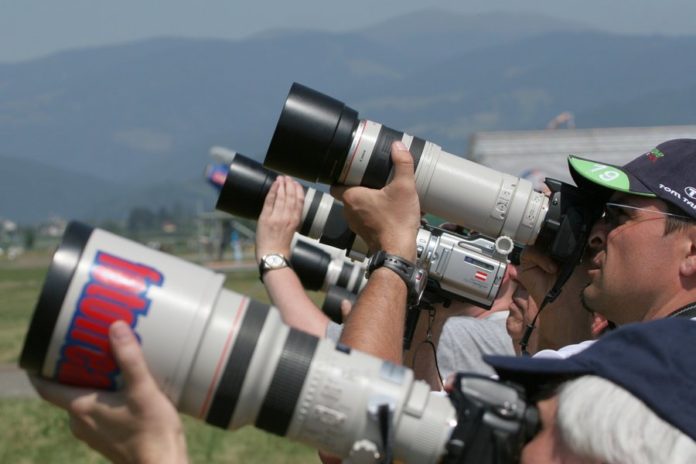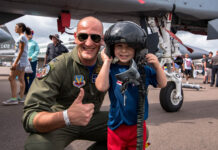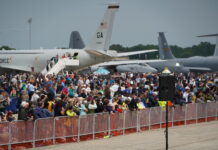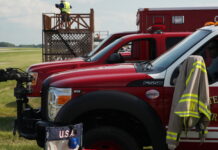The exponential expansion of the internet combined with the accessibility of inexpensive digital cameras has caused some blurring of the term, “media.” Photographers and authors can now create and publish blogs and photo galleries accompanied by air show reviews and editorials. Groups of aviation enthusiasts coordinate forums and photo sharing. This process of sharing imagery with other photographers and the general public has enabled some passionate fans to identify themselves as “media” without any clear or meaningful journalistic affiliation or experience. There is probably not an air show anywhere in the country that has not been forced to have an internal conversation about who is and who is not “media,” who should or should not be permitted media-type access.
I am a professional photographer myself. Far from being sympathetic to this spike in photographers claiming media access, I believe that this development is an unnecessary and unproductive drain on the limited resources of individual air shows.
For purposes of this discussion, here’s how I would define “media”: An official media representative is any person or organization that will spread the news of your venue through local channels which result in an immediate increase of revenue during the dates of your event.
So, by definition, that guy who wants to provide coverage of your show for a European magazine is not media. The person who submits images from your event to annual calendar companies or aircraft manufacturers is not media. Those folks who post images online to their galleries or favorite forums with air show reviews are not media. That individual asking for media credentials to build his library of stock aviation footage is also not media. By that definition, one can even go so far as to exclude magazine publishers and documentary producers.
The argument posed by most photographers and authors is that they are publicizing your event at no cost to you. Well, that’s not really true. While photographers are publicizing your event, it won’t do anything to help your current revenue stream until the following year…at best. And the publicity that photographers provide still comes at a cost since hosting media isn’t typically free. Some venues provide free food, pay port-a-potty rental, fencing, chairs, and tents. The photographers “consume” precious space on the flight line space and volunteer time and attention. Not to mention the unrealized revenue of individuals who would have probably purchased a ticket if the show had not let them in for free as “media.” These are all resources that, quite literally, come off the air show’s bottom line.
The simple point is that your air show is a business and the avid aviation enthusiasts that attend are still spectators. The principal difference between those photographers and the average family is that the photographer is trying very hard to make money from your show (though, admittedly, not many of them succeed and, when they do, it’s not much money). As a business, an air show has every right to either place tighter controls on who qualifies as media or tap into to some that revenue generated by the photographer since you are providing the opportunity to begin with or both.
Business aside, there’s an even bigger reason to establish who is actually accredited media and to what point can they be trusted to adhere to the rules of the ramp. Groups of photographers roaming the ramp are an unnecessary distraction to those charged with ensuring proper conduct of the air show and a potential safety hazard.
For all those reasons, it would be wise for the air show community to collaborate and work on an industry-wide set of parameters.
Understanding the Photographer’s Needs
Understanding the goal of amateur, advanced amateur and professional photographers and how they differ from the media should be the primary focus of any air show committee looking for a viable solution.
Accredited journalists will, for the most part, spend little time photographing the action taking place along the flight line and beyond. Instead they will be on a time-sensitive mission to capture emotional images of children interacting with vendors or pilots, families touring aircraft or eating food, flight crews prepping and sharing the features of their aircraft, and other human aspect images. In general, when not being escorted to various scheduled interviews, most of the photographers and journalists are fairly self-sufficient.
Unlike fully-accredited media, the primary goal of aviation photographers is to capture dynamic images of aircraft as well as documenting those present at the air show. Rarely do aviation-specific photographers desire to capture the human aspect of the venue. For those that wish to document the interactions and overall feel of an air show by wandering the grounds, there are issues air show coordinators should be aware of in order to capitalize on revenue and accommodate the aviation enthusiast.
The primary gripe with photographers who are mixed in with the general admission crowd is the lack of security and respect for their equipment. It’s not uncommon for a photographer — amateur or otherwise — to carry at least $30,000 in equipment with them. For this type of photographer, there have been ongoing issues related to finding a position on the crowd line where kids aren’t kicking their equipment or having a secure area where they can comfortably leave their gear.
Many shows have found a very simple and elegant solution. They have established photo tours and/or photo pits that simultaneously address multiple concerns. These programs have given serious photographers the opportunity to gain a perspective not seen by the general spectator and provide the kind of security they want for themselves and their equipment. At the same time, these programs have created a new revenue stream for the air shows that organize and conduct them, enough – in most cases – to pay for the related expenses and produce a small surplus.
There will be an expense in both time and money on behalf of your air show to put either of these two programs to work. A photo tour is the more complicated of the two and consists of multiple gatherings over the three- or four-day weekend. Photographers typically gain access to the airport grounds on Thursday or Friday before the show in order to photograph aircraft without the numerous spectators and barricades surrounding them. This can often take place at the break of dawn for that early light or a sunset gathering for a similar mood. Photo tours also include at least one or more locations from which photographers can gain a different perspective. At the conclusion of the show, photographers who take part in the photo tour are often welcomed back on Monday to photograph departing aircraft from the side of the runway or some other unique vantage point.
To make this happen, the air show must communicate with the FAA, ground boss and air boss at a minimum to explain what you’re doing and how you’re doing it. Volunteers must be secured to conduct the tours. And these volunteers must have a working knowledge of both the aircraft and the photographer mentality. I say this due to the fact that photographers tend to meander to wherever the photo is, not necessarily where invisible barriers may lie. Credentials need to be made visible and depending on FAA requirements, high-visibility vests or clothing may also be needed.
Whether it is organized as part of the photo tour or made to be a stand-alone option, the photo pit is typically a fixed area just outside the aerobatic box. It is usually located in a favorable area for photography based on the positioning of the sun and proximity of the aircraft. Importantly, it should not be at or near show center. This position is not most desirable as far as photographers are concerned.
If getting in or out of the photo pit area impacts air show operations, those taking part in a photo pit program are usually expected to stay for the duration of the show, arriving before the aerobatic box becomes active and staying until after the last act has concluded. A photo pit requires a full-time escort with the means to communicate to the air boss when transitioning to and from the area. Expenses on behalf of your air show may include a portable tent, port-a-potty, water, a van for transporting photographers, possibly fencing and food.
Fees to participate in either the photo tour or the photo pit can and should be significantly higher than those for a general admission ticket.
If either a photo tour or photo pit is impractical, your air show can offer special photography packages that allow photographers other perks. Paid incentives such as closer parking, early admission and perhaps their own isolated area on the flight line to safely leave the bulk of their gear while they wander the air show grounds would be a welcome treat for photographers.
Conveying this message could be a simple matter of applying your media expectations on your marketing website and enabling photographers to apply for the appropriate level. In addition to the other benefits already listed, the availability of a photo tour or photo pit provides air show management with a reasonable alternative to those individuals who insist on media access but don’t meet your show’s definition of working press.
Beyond Media
If you feel there is now a definitive line between media and non-media, I’m going to blur it again. There are photographers and writers out there who have been a part of the aviation scene for many years. They may not fit the definition of media, but they certainly do the industry a service by directly or indirectly assisting your air show or your sponsors. And they understand the fundamentals of aviation safety.
In addition to these exceptions to the rule, there are also organizations that promote a sort of kinship with the industry and insist on a code of conduct. The International Society of Aviation Photographers (ISAP) is one of those organizations that works hard for the respect of the air show industry. This by no means entitles anyone from ISAP or other aviation-related photography organizations to receive a media badge, but it may warrant a third type of credential.
For some of these individuals who contribute to your show in some real and tangible way, a staff badge may be appropriate. It’s up to your air show committee to decide how these credentials should be handled and what verbiage should be used. Additionally, event leaders would not be out line in requesting a certain number of images from the specially accredited photographers as a way of earning that credential. Members of ISAP are encouraged to provide a small number of photos, albeit not the absolute best as some members still do have a business to maintain, but approximately 20-30 of their second tier photos, to the accrediting air show.
The air show industry is and always will be under a magnifying glass by the general public and governing authorities. While the industry has proven itself to be one of the safest forms of entertainment on the planet, there will always be room for improvement. Currently, the situation involving media and those wishing to be considered media has simply gotten out of hand since there is no existing industry guideline on what media actually is. For now, it is up to the individual air show to determine how media credentials are assigned. Because every air show management team is different, this has led to misguided expectations on behalf of those being given credentials.
With an industry-wide set of guidelines, air shows, media professionals and photographers of every level will come to know what is expected of them and, in turn, they will know what to expect from the air show.
I suggest three forms of media credentials:
- Accredited Media: Media professionals who work for an established organization that will provide news coverage that has the potential to directly increase attendance for the duration of the venue.
- Staff or Volunteer Media: Photographers who are working on behalf of the air show to provide photos and footage for future marketing efforts. Also those who are well known throughout the industry and can work safely in the air show environment with little or no supervision.
- Photo Pit or Photo Tour Participants: Reserved for those photographers who wish to achieve better access than the general spectator but are new to the industry, hobbyists, advanced amateur and professional photographers alike.
We all recognize that the ultimate solution to this problem will evolve through experience. But that process must have a starting point and I propose this one. I look forward to working with ICAS and all of its members toward a long-term solution to this challenge.
More About ISAP
The International Society of Aviation Photographers was founded in 2001 by three industry image leaders: Jay Miller, Chad Slattery and Denny Lombard. The goal of the organization is to combine the experience of the professional with those looking to enter the world of aviation photography for increased safety both on the ground and in the air as well as provide an unparalleled resource of aviation photography knowledge.
Part of becoming a member of ISAP is agreeing to a code of conduct whereby photographers understand the impact of their actions on the industry. Failure to comply results in immediate expulsion from the organization.
Understanding the need for consistency and safety within the air show industry, ISAP is looking into the creation of a training program that will certify a limited number of photographers for access beyond the flight line. This curriculum will be overseen by ICAS in order to verify certified photographers are capable of being entrusted with special access and understand what exactly air shows are looking for in regard to promotional material.
Working with Photo Flight Requests
Many air shows are faced with requests for air-to-air coverage of participating performers and aircraft. There are typically two types of people who make these requests; accredited media and professional or avid aviation photographers.
Since it is the air show that usually foots the bill for fuel, photo flights should only be launched for media efforts likely to produce coverage that increases air show attendance. In this case, media would be described as any entity providing publicity for your event that will result in immediate financial return.
Unfortunately, accredited media photographers typically do not have the experience to create visually stunning imagery. Nor is it their job to do so. So long as they bring back an image that tells a story, they’ve accomplished their goal. However, there is an efficient and financially productive answer to achieving better archival imagery from the same photo flight.
Let’s say you have a local performer who returns annually and you need spectacular images of that individual for future use. Local media can provide images, but they will most likely be of mediocre quality and not necessarily in the format your graphics people need for your various advertising projects. Pairing a media professional with an experienced aviation photographer can increase your total exposure, but communication is paramount.
Like your event, a professional aviation photographer has a business to run and giving images away for free is bad for business. But, like you, the photographer understands that a little bit of give and take is vital for eventual success. Request that, in exchange for the professional photographer joining the photo flight, the show be given use of a certain number of images created during the flight. Working with the photographer will enable your show to not only increase your archive of imagery for your website, program, posters, pamphlets, etc., but it will also enable the photographer to promote both your air show and the performer in post-show publications.
Expect there to be some limitations on your use of those images. Photographers will continue to own their images, not the air show. And while the air show will be able to use the images, they will not be permitted to distribute the photography without the photographer’s permission. You should expect that your show will be prohibited from giving imagery to air show and performer sponsors, enabling newspapers and magazines the ability to publish their photos outside of the standard ad placement, placing hi-resolution photos up for grabs on the air show’s website, etc.. When in doubt, ask the photographer. There is usually a common solution that will work in the best interest of both parties. Photographers are just as excited to be on a photo flight as you are to make use of their imagery. Finding an amicable way to make the best use of your resources is easily achievable with proper communication and an understanding of everyone’s goals.








